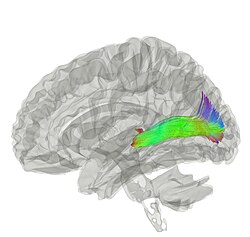This article includes a list of references, related reading, or external links, but its sources remain unclear because it lacks inline citations. (May 2015) |
| Optic radiation | |
|---|---|
 Colour-coded diagram showing radiations in quadrants from retinal disc through the brain | |
 Tractography showing optic radiation | |
| Details | |
| System | Visual system |
| Function | Vision |
| Identifiers | |
| Latin | radiatio optica |
| NeuroNames | 1440 |
| TA98 | A14.1.08.673 A14.1.09.542 A14.1.09.547 |
| TA2 | 5584 |
| FMA | 61941 |
| Anatomical terms of neuroanatomy | |
In neuroanatomy, the optic radiation (also known as the geniculocalcarine tract, the geniculostriate pathway, and posterior thalamic radiation) are axons from the neurons in the lateral geniculate nucleus to the primary visual cortex. The optic radiation receives blood through deep branches of the middle cerebral artery and posterior cerebral artery.
They carry visual information through two divisions (called upper and lower division) to the visual cortex (also called striate cortex) along the calcarine fissure. There is one set of upper and lower divisions on each side of the brain. If a lesion only exists in one unilateral division of the optic radiation, the consequence is called quadrantanopia, which implies that only the respective superior or inferior quadrant of the visual field is affected. If both divisions on one side of the brain are affected, the result is a contralateral homonymous hemianopsia.